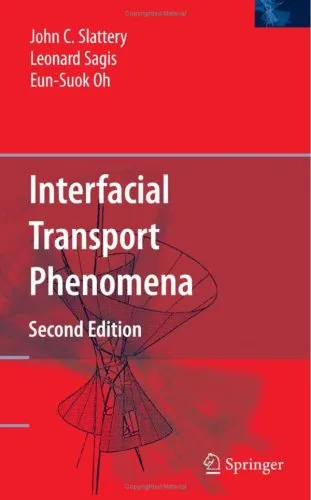Interfacial transport phenomena
4.5
Reviews from our users

You Can Ask your questions from this book's AI after Login
Each download or ask from book AI costs 2 points. To earn more free points, please visit the Points Guide Page and complete some valuable actions.Introduction to 'Interfacial Transport Phenomena'
"Interfacial Transport Phenomena" is a comprehensive exploration of the principles and mechanisms governing the transport of mass, momentum, and energy at interfaces. Authored by John C. Slattery, this book delves deep into the fundamental and applied aspects of interfacial science, providing readers with a framework to understand the complex dynamics of transport phenomena in multiscale systems. Designed to accommodate the needs of both students and professionals, this work bridges a vital knowledge gap in the field of fluid mechanics, thermodynamics, and chemical engineering.
Whether you are a researcher delving into advanced interfacial systems or a graduate student seeking foundational clarity, this book provides both theoretical tools and practical insights to help you model and analyze interfacial transport phenomena in real-world applications.
Detailed Summary of the Book
The book begins by building a foundational understanding of interfacial transport processes, emphasizing the physical, chemical, and thermodynamic principles that dictate these behaviors. Interfacial phenomena are ubiquitous in nature and engineered systems, and this book systematically handles the complexities that arise from interfacial boundaries in various phases—gases, liquids, solids, or combinations of these.
Some of the pivotal topics covered include:
- The role of capillarity and surface tension in microscale and nanoscale systems.
- Mass transfer across interfaces with a focus on diffusion, adsorption, and reactions.
- The influence of interfacial transport on momentum transfer, including the uniqueness of interfacial viscosity and Newtonian behavior in some cases.
- Energy transfer at interfaces with emphasis on conduction, convection, and radiation mechanisms.
- Mathematical formulations and boundary conditions for transport problems.
The book also incorporates advanced topics such as Marangoni effects, enhancement of transport due to interfacial instabilities, and the behavior of multicomponent systems at interfaces. Case studies and problem-driven learning are integral components of the book, allowing readers to apply theories to scenarios encountered in industries such as petroleum engineering, pharmaceuticals, and materials science.
Key Takeaways
- A Holistic Understanding of Interfaces: The book offers readers a profound understanding of interfacial transport processes, analyzing interactions between phases and their influence on macroscopic system behavior.
- Practical Frameworks: The mathematical modeling approaches outlined in the book serve as invaluable tools for problem-solving in engineering and scientific research.
- Cross-Disciplinary Insights: Concepts included in the text are reinforced with practical relevance across fluid mechanics, materials science, and environmental engineering.
- Comprehensive Reference: A great resource for researchers, engineers, and educators working in the fields of fluid and heat transfer, with sufficient depth to cater to advanced studies.
The text is enriched with diagrams, derivations, and analytical examples that guide readers in visualizing and interpreting complex interfacial behavior.
Famous Quotes from the Book
"The study of interfacial transport is not merely an inquiry into boundary phenomena, but a fundamental investigation into what holds systems together—or, in cases of instability, drives them apart."
"The elegance of nature lies in its interfaces, where the laws of physics and chemistry converge to orchestrate the transport of matter and energy."
"Mastering interfacial transport phenomena is akin to decoding the language that governs interactions between the microscopic and macroscopic worlds."
Why This Book Matters
Interfacial transport phenomena are critical to numerous scientific and industrial applications. From understanding the dynamics of a single fluid droplet to engineering complex systems such as emulsions, foams, or membranes, the principles outlined in this book find applications in diverse fields such as biomedical engineering, wastewater treatment, and energy storage systems.
By presenting a detailed and unified theory of interfacial phenomena, the book empowers scientists and engineers to design better materials, optimize industrial processes, and solve challenging problems with confidence. It fills a crucial void in chemical and mechanical engineering literature by offering an in-depth analysis of non-continuous systems where interfaces dominate transport behavior.
Moreover, "Interfacial Transport Phenomena" inspires a deeper appreciation for the elegance of nature and the universality of scientific principles, making it an essential read for academics and practitioners alike.
Free Direct Download
You Can Download this book after Login
Accessing books through legal platforms and public libraries not only supports the rights of authors and publishers but also contributes to the sustainability of reading culture. Before downloading, please take a moment to consider these options.
Find this book on other platforms:
WorldCat helps you find books in libraries worldwide.
See ratings, reviews, and discussions on Goodreads.
Find and buy rare or used books on AbeBooks.


